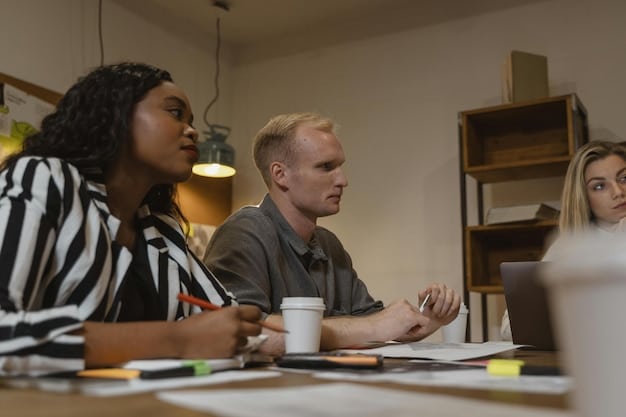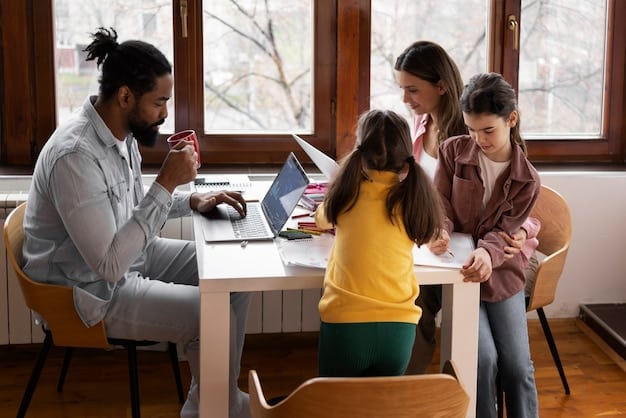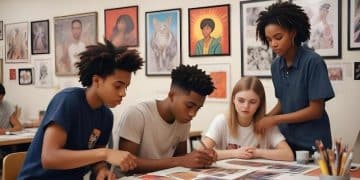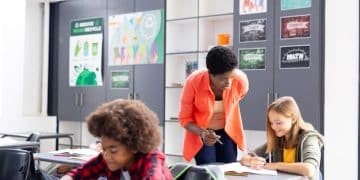Learning Style Conflicts in Group Projects: Identify & Overcome Guide

Learning style conflicts in group projects can hinder collaboration and productivity; this step-by-step guide helps you identify these conflicts and implement effective strategies to overcome them, fostering a more inclusive and successful team environment.
Group projects can be challenging, especially when team members have different learning preferences. Understanding how to identify and overcome learning style conflicts in group projects: a step-by-step guide can significantly improve team dynamics and project outcomes.
Understanding Learning Styles in Group Dynamics
Learning styles are the diverse ways individuals prefer to absorb, process, and retain information. Recognizing these differences is crucial in a group setting to ensure everyone can contribute effectively. Understanding the different learning styles can lead to more effective teamwork and better project results.
Common Learning Style Models
Several models categorize learning styles. Among the most well-known are the VARK model and the Kolb Learning Style Inventory. Each model provides a framework for understanding various learning preferences.
Understanding these models can help you better identify the learning style preferences within your group.
- VARK Model: This model identifies four primary learning styles: Visual, Auditory, Read/Write, and Kinesthetic. Visual learners prefer diagrams and charts, auditory learners prefer lectures and discussions, read/write learners prefer written materials, and kinesthetic learners prefer hands-on experiences.
- Kolb Learning Style Inventory: This model proposes four learning styles based on a two-by-two matrix: Diverging (feeling and watching), Assimilating (thinking and watching), Converging (thinking and doing), and Accommodating (feeling and doing).
- Multiple Intelligences Theory: While not strictly a learning style model, Howard Gardner’s theory of multiple intelligences suggests that individuals have different intellectual strengths. Catering to these different intelligences can enhance learning in group settings.
Recognizing and accommodating these different models will promote a more inclusive and effective collaboration environment.
Identifying Learning Style Conflicts
Learning style conflicts arise when team members’ preferred learning methods clash, leading to misunderstandings and inefficiencies. This section outlines how to spot these conflicts early and mitigate their impact. Recognizing these problems early can foster a more inclusive and productive working environment.

Recognizing Verbal and Non-Verbal Cues
Paying attention to how team members communicate can provide clues about their learning preferences. Verbal cues include statements about learning preferences, while non-verbal cues include body language and engagement levels.
Remaining vigilant about verbal and non-verbal cues leads to the early detection of potential problems.
Active Listening and Observation Techniques
Use active listening skills to encourage team members to express their needs and preferences. Observe how different members engage with various tasks and materials. Noticing these behaviors can offer insights into different learning styles.
- Ask Open-Ended Questions: Encourage team members to articulate their preferred learning methods and what helps them grasp new concepts.
- Monitor Engagement Levels: Notice which activities or presentations garner the most attention and participation from each member.
- Assess Task Performance: Observe how different team members approach tasks. Do they prefer visual aids, written instructions, or hands-on demonstrations?
These techniques facilitate a deeper understanding of your teammates and their unique learning styles.
By identifying these conflicts early, teams can implement strategies to accommodate diverse learning styles, promoting a more collaborative and effective environment.
Assessing Individual Learning Styles
To effectively address learning style conflicts in group projects, it’s essential to assess each member’s individual learning style. This involves using various tools and techniques to understand how each person best absorbs and processes information. Identifying each person’s learning style can facilitate a more tailored and collaborative process.
Utilizing Learning Style Questionnaires
Learning style questionnaires are a structured way to gather insights into individual preferences. These questionnaires often use multiple-choice questions to identify whether someone is more of a visual, auditory, reading/writing, or kinesthetic learner.
There are tools that are designed to provide a structured understanding of learning methods and individual preferences.
Conducting Informal Interviews
Informal interviews can complement the data gathered from questionnaires by providing richer, qualitative insights. Simply asking team members about their preferred study habits and how they best understand new material can be revealing.
- Prepare Open-Ended Questions: Ask questions that encourage detailed responses about preferred learning methods.
- Listen Actively: Pay close attention to the language used and the examples provided.
- Summarize and Validate: Summarize what you heard to ensure understanding and give the interviewee a chance to clarify or add more insights.
These interviews and questionnaires create a well-rounded understanding of individual learning style and team needs.

Strategies for Accommodating Diverse Learning Styles
Once you’ve identified the learning styles within your group, the next step is to implement strategies that accommodate these diverse preferences. An inclusive and supportive learning environment increases engagement and productivity.
Multimodal Content Delivery
Presenting information in multiple formats caters to various learning styles. Use a combination of visual aids, auditory explanations, written materials, and hands-on activities.
A multimodal approach improves understanding for a variety of people, no matter learning preference.
Flexible Task Assignments
Assign tasks that align with individual learning style strengths. For example, a visual learner might excel at creating presentations, while an auditory learner might be better suited for leading discussions.
Adjusting assignments according to the strengths of the teammates maximizes their effectiveness.
Encouraging Peer Teaching and Mentoring
Peer teaching and mentoring can be highly effective, particularly when team members with different learning styles teach each other. This allows for concepts to be explained in multiple ways, reinforcing understanding.
- Pair Visual Learners with Auditory Learners: Have visual learners create diagrams that auditory learners can explain.
- Encourage Active Listening: Promote active listening and feedback during peer teaching sessions.
- Facilitate Hands-On Demonstrations: Encourage team members to demonstrate concepts through hands-on activities.
Implementing these strategies can transform your group project from a challenge into a collaborative learning opportunity.
Fostering Open Communication and Collaboration
Creating an environment that fosters open communication is essential for effectively addressing learning style conflicts. Open communication allows team members to express their needs and contribute their unique perspectives. In an open environment, everyone feels comfortable articulating their learning requirements, facilitating easier problem and difficulty identification.
Establishing Ground Rules for Communication
Establish clear guidelines for how team members should communicate with each other. Encourage respectful listening, constructive feedback, and open expression of concerns.
These ground rules for communication foster a respectful and proactive environment.
Using Collaboration Tools Effectively
Leverage technology to facilitate communication and collaboration. Utilize tools like project management software, shared document platforms, and video conferencing to keep everyone connected and informed.
- Project Management Software: Use tools like Trello or Asana to track progress, assign tasks, and facilitate communication.
- Shared Document Platforms: Use Google Docs or Microsoft OneDrive for real-time collaboration on documents and presentations.
- Video Conferencing: Use Zoom or Microsoft Teams for virtual meetings and brainstorming sessions.
Using these collaboration tools ensures efficient teamwork.
By cultivating an environment where team members feel valued and heard, you can create a more effective and enjoyable collaborative experience when managing learning style conflicts in group projects.
Evaluating and Adapting Strategies
The strategies employed to address learning style conflicts in group projects should not be static; they should evolve based on ongoing evaluation and feedback. Consistent evaluation allows you to fine-tune your approach and maximize the effectiveness of the collaboration.
| Key Aspect | Brief Description |
|---|---|
| 🤝Understanding Learning Styles | Recognize VARK & Kolb models. |
| 👂Active Listening | Observe verbal & non-verbal cues. |
| 🛠️Multimodal Approaches | Use diverse content formats. |
| 🗣️Open Communication | Create respect & clear guidelines. |
Frequently Asked Questions
The most common learning style models include VARK (Visual, Auditory, Read/Write, Kinesthetic), Kolb’s Learning Style Inventory, and the Multiple Intelligences Theory. Each offers ways of understanding different learning strengths.
Look for verbal and non-verbal communication cues. If some team members look bored, disengaged, or confused, there may be such a conflict. Open communication also facilitates a better understanding.
Multimodal content delivery involves presenting information in various formats to accommodate different learning styles. Incorporating text, presentations, and hands-on activities are all essential in the process.
Tools like project management software and shared document platforms enhance communication. This creates a better organized and connected workflow leading to a good outcome. Video conferencing also helps.
Regular team feedback ensures strategies remain relevant to the individual needs, and adjustments are made to improve teamwork. Consistent communication guarantees maximum effectiveness.
Conclusion
Overcoming learning style conflicts in group projects requires awareness, flexibility, and a commitment to open communication. By identifying individual learning preferences, implementing inclusive strategies, and continuously evaluating team dynamics, you can create a more effective and enjoyable learning environment for everyone involved.





